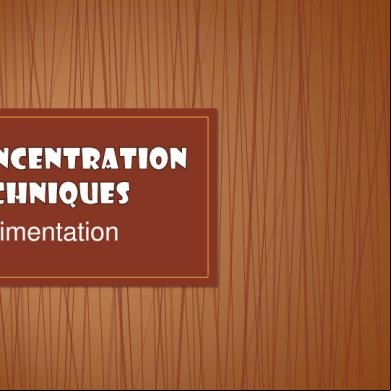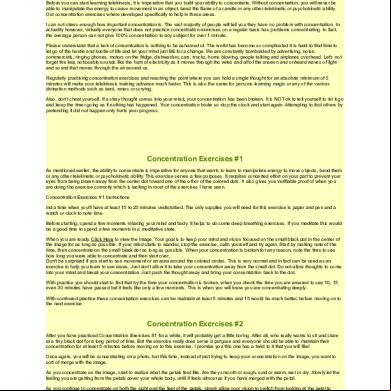Concentration Techniques.pptx 1ig1n
This document was ed by and they confirmed that they have the permission to share it. If you are author or own the copyright of this book, please report to us by using this report form. Report l4457
Overview 6h3y3j
& View Concentration Techniques.pptx as PDF for free.
More details h6z72
- Words: 763
- Pages: 14
Sedimentation
• On light infection, even Kato-Thick smear may not detect it, concentration of the fecal sample is done. One of these concentration techniques is Sedimentation. Straining and Sedimentation is applied on this technique, Centrifugation may also be applied.
• The principle of this technique is that heavy substances(such as helminthic eggs, larvae, cyst, operculated and schistosoma eggs) tend to go down, and lighter substances (debris) will float up. • In this technique the sediments will be subjected to microscopic analysis
• • • • • •
Stool Specimen Tongue Depressor Gauze pad Glass Slide and Cover Slip Centrifuge Machine Centrifuge tube
• • • • •
0.5% glycerinated water Glass cylinder Glass funnel Pasteur Pipet Microscope
• Group 8
406th Medical General Laboratory
• Prepare fecal suspension of 10 parts of water and 1 part stool specimen. • Mix thoroughly • Strain using 2 layers of gauze, collect it in 15 ml centrifuge tube • Add NSS until tube is ¾ full (0.5% glycerinated water) • Centrifuge for 2 min. @ 1500rpm • Decant the supernatant • Repeat the process, up to 3 times
• • • • • • • • •
Add 7ml of 10% Formalin Stand for 5 to 10 min Add 3ml of formalized specimen Mix thoroughly Centrifuge for 2 min @ 1500 rpm Ether, superficial debris and formalin are decant Pipette a drop of the sediment to the glass slide Add a drop of NSS Examine under microscope
• Potassium Hydroxide Concentration Method for Cyclospora (Berlin et al., 1994) • • • • • • • • • •
10% KOH Stand for 5 min Saline Filter with 4 layers of gauze Centrifuge Decant Saline Centrifuge Decant Examine sediment
• Ritchie Concentration Method • - same as Formalin-Ether Concentration Technique only that it uses Ethyl Acetate instead of ether • Sedimentation in water • Not effective as a concentration Technique
• Acid-Ether Sedimentation • • • •
Dissolves mucus and other various substance Unsatisfactory for the diagnosis of protozoa Useful for detection of schistosome and other trematode eggs 15% HCl
• • • • • • •
Acid Strain Centrifuge Acid Ether Centrifuge Study Sediment
• Adaptation of Ritchie's Method for Parasites Diagnosing with Minimization of Chemical Products •
Régis Silva Anécimo, Karina A. A. Tonani, Brisa Maria Fregonesi, Ana Paula Mariano, Marinês D. B. Ferrassino, Tânia M. B. Trevilato, Roberta Braga Rodrigues, and Susana I. Segura-Muñoz Central Laboratory of Clinical Pathology, University Hospital, University of São Paulo at Ribeirão Preto Medical School, 14040-902 Ribeirão Preto, SP, Brazil Laboratory of Ecotoxicology and Environmental Parasitology, University of São Paulo at Ribeirão Preto College of Nursing, Avenida Bandeirantes 3900, Campus Universitário, 14040-902 Ribeirão Preto, SP, Brazil Microtechnics/Metal Sector, University of São Paulo at Ribeirão Preto Medical School Hospital das Clínicas, 14040-902 Ribeirão Preto, SP, Brazil
•
Received 31 May 2012; Accepted 8 July 2012
•
Academic Editor: Oladele O. Kale
•
Copyright © 2012 Régis Silva Anécimo et al. This is an open access article distributed under the Creative Commons Attribution License, which permits unrestricted use, distribution, and reproduction in any medium, provided the original work is properly cited.
• Abstract • Latin America, Africa, and Asia present wide dissemination and high prevalence rates of waterborne parasitic diseases, which is a strong indicative of the fragility of public sanitation systems. In this context, parasitological analyses represent extremely relevant instruments. Several parasite diagnosis methods exist, among which Ritchie’s method (1948) stands out. This method uses formaldehyde and ether, two reagents of toxicological importance that can cause damages to environmental and occupational health. The present study aimed to compare Ritchie’s method modified by Régis Anécimo, without use of solvents, with the traditional Ritchie’s method, routinely used for helminth and protozoa diagnosing in Brazil. Some changes were introduced in the modified method, such as controlled increase of water temperature used after stool dilution and substitution of formaldehyde and ether by a neutral detergent before material centrifugation for observation of parasites. In examined samples by both methods, multiple infections were commonly observed; the modified method presented a similar sensitivity to identify the parasites. The development of analytic diagnosis methods that minimize the use of chemical products like ether and formaldehyde represents an important tool to prevent occupational diseases among exposed professionals, as well as to preserve environmental quality through the use of clean techniques.
• Update: http://www.hindawi.com/journals/ipid/2012/409757 Accessed on January 16, 2013)
(Last
• Beaver, Jung and Cupp, “ Clinical Parasitology 9th ed.”, 1984 • John and Petri, “Markell and Voge’s Medical Parasitology 9th ed.” 2010 • Brown and Neva, “Clinical Parasitology”, 1983
• On light infection, even Kato-Thick smear may not detect it, concentration of the fecal sample is done. One of these concentration techniques is Sedimentation. Straining and Sedimentation is applied on this technique, Centrifugation may also be applied.
• The principle of this technique is that heavy substances(such as helminthic eggs, larvae, cyst, operculated and schistosoma eggs) tend to go down, and lighter substances (debris) will float up. • In this technique the sediments will be subjected to microscopic analysis
• • • • • •
Stool Specimen Tongue Depressor Gauze pad Glass Slide and Cover Slip Centrifuge Machine Centrifuge tube
• • • • •
0.5% glycerinated water Glass cylinder Glass funnel Pasteur Pipet Microscope
• Group 8
406th Medical General Laboratory
• Prepare fecal suspension of 10 parts of water and 1 part stool specimen. • Mix thoroughly • Strain using 2 layers of gauze, collect it in 15 ml centrifuge tube • Add NSS until tube is ¾ full (0.5% glycerinated water) • Centrifuge for 2 min. @ 1500rpm • Decant the supernatant • Repeat the process, up to 3 times
• • • • • • • • •
Add 7ml of 10% Formalin Stand for 5 to 10 min Add 3ml of formalized specimen Mix thoroughly Centrifuge for 2 min @ 1500 rpm Ether, superficial debris and formalin are decant Pipette a drop of the sediment to the glass slide Add a drop of NSS Examine under microscope
• Potassium Hydroxide Concentration Method for Cyclospora (Berlin et al., 1994) • • • • • • • • • •
10% KOH Stand for 5 min Saline Filter with 4 layers of gauze Centrifuge Decant Saline Centrifuge Decant Examine sediment
• Ritchie Concentration Method • - same as Formalin-Ether Concentration Technique only that it uses Ethyl Acetate instead of ether • Sedimentation in water • Not effective as a concentration Technique
• Acid-Ether Sedimentation • • • •
Dissolves mucus and other various substance Unsatisfactory for the diagnosis of protozoa Useful for detection of schistosome and other trematode eggs 15% HCl
• • • • • • •
Acid Strain Centrifuge Acid Ether Centrifuge Study Sediment
• Adaptation of Ritchie's Method for Parasites Diagnosing with Minimization of Chemical Products •
Régis Silva Anécimo, Karina A. A. Tonani, Brisa Maria Fregonesi, Ana Paula Mariano, Marinês D. B. Ferrassino, Tânia M. B. Trevilato, Roberta Braga Rodrigues, and Susana I. Segura-Muñoz Central Laboratory of Clinical Pathology, University Hospital, University of São Paulo at Ribeirão Preto Medical School, 14040-902 Ribeirão Preto, SP, Brazil Laboratory of Ecotoxicology and Environmental Parasitology, University of São Paulo at Ribeirão Preto College of Nursing, Avenida Bandeirantes 3900, Campus Universitário, 14040-902 Ribeirão Preto, SP, Brazil Microtechnics/Metal Sector, University of São Paulo at Ribeirão Preto Medical School Hospital das Clínicas, 14040-902 Ribeirão Preto, SP, Brazil
•
Received 31 May 2012; Accepted 8 July 2012
•
Academic Editor: Oladele O. Kale
•
Copyright © 2012 Régis Silva Anécimo et al. This is an open access article distributed under the Creative Commons Attribution License, which permits unrestricted use, distribution, and reproduction in any medium, provided the original work is properly cited.
• Abstract • Latin America, Africa, and Asia present wide dissemination and high prevalence rates of waterborne parasitic diseases, which is a strong indicative of the fragility of public sanitation systems. In this context, parasitological analyses represent extremely relevant instruments. Several parasite diagnosis methods exist, among which Ritchie’s method (1948) stands out. This method uses formaldehyde and ether, two reagents of toxicological importance that can cause damages to environmental and occupational health. The present study aimed to compare Ritchie’s method modified by Régis Anécimo, without use of solvents, with the traditional Ritchie’s method, routinely used for helminth and protozoa diagnosing in Brazil. Some changes were introduced in the modified method, such as controlled increase of water temperature used after stool dilution and substitution of formaldehyde and ether by a neutral detergent before material centrifugation for observation of parasites. In examined samples by both methods, multiple infections were commonly observed; the modified method presented a similar sensitivity to identify the parasites. The development of analytic diagnosis methods that minimize the use of chemical products like ether and formaldehyde represents an important tool to prevent occupational diseases among exposed professionals, as well as to preserve environmental quality through the use of clean techniques.
• Update: http://www.hindawi.com/journals/ipid/2012/409757 Accessed on January 16, 2013)
(Last
• Beaver, Jung and Cupp, “ Clinical Parasitology 9th ed.”, 1984 • John and Petri, “Markell and Voge’s Medical Parasitology 9th ed.” 2010 • Brown and Neva, “Clinical Parasitology”, 1983










